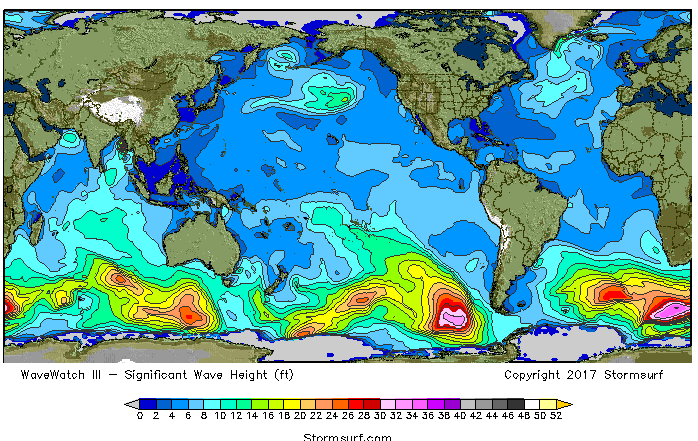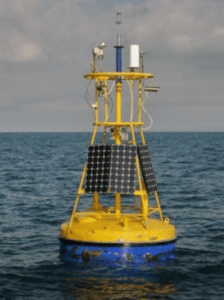Swells 102: Ground Swell Versus Windswell
Share
As we learned in Swells 101, waves are created by the action of wind across the surface of water. Once created, these waves travel through the water until they eventually decay and dissipate. But while they travel through the water, something interesting happens. Because raw, recently created waves are chaotic and disorganized, they tend to move at different speeds and in slightly different directions. Over long distances and long periods of time, the faster-moving waves catch up with the slower-moving waves, and these waves join together. After many hundreds and even thousands of miles of travel, these waves tend to group themselves into what we call “sets,” or groups of waves that are close together. Collectively, these sets of waves make up a swell, which is the total wave event created by a specific storm.
This joining together of waves is quite interesting to surfers, sailors, and oceanographers alike. You see, as these waves join together, they become stronger and more organized—and the farther they travel, the more chance they have to catch up with other waves and join with them. So while a wave might decay and become “smaller” the farther it travels, it also becomes cleaner and more powerful due to the fact that it has joined up with many other waves. This also creates larger gaps between waves, since there are now less actual waves moving through the water (although not less energy, since many of the waves have joined forces, so to speak). These gaps are measured by what we call period, or the amount of time between waves as they move through the water. The farther waves move away from the storm that created them, the more they join up with other waves, and the longer the period becomes. Thus, waves that are located in close proximity to the storm may have a period of 3 or 4 seconds, while waves that have traveled thousands of miles may have periods as long as 23 and 24 seconds.
Now the really interesting thing about period is that it measures more than just the distance between waves. It also measures the speed that a swell is moving. And, just as importantly, it measures the distance that a swell extends below the surface of the water. As a rule, the greater the period, the faster a swell moves, and the bigger the swell is under water. Thus, a 4 feet at 6 second swell might be seen as being 4 feet tall above the surface of the ocean, and only extend 92 feet below the surface, while a 4 feet at 18 second swell will also appear to be only four feet tall above the surface of the ocean, but will extend 829 feet below the surface. (The formula to figure out how deep a wave extends below the surface is to square the period and then multiply it by 2.56.) Not only does this make the swell stronger and more organized, but it also means that it moves faster and feels the bottom contours of the ocean (or bathymetry) sooner, since it reaches deeper below the surface.
The implications of a stronger, faster-moving, deeper-reaching swell are many. First of all, when estimating the arrival of a swell based on buoy readings, the period must be taken into account, since that tells us the speed at which the swell is moving. When buoy 51101 shows a north swell with 15 second period, we can expect that swell to hit the North Shore around 10 hours later, while an 18-second swell will hit in around 8 hours. Furthermore, the greater the period, the more powerful and larger the swell will tend to be when the waves actually shoal and break. This is due not only to the increased speed and strength caused by waves joining together, but also the way that the swell feels the bathymetry of the ocean. Remember, an 18-second swell reaches 829 feet below the surface, while a 6-second swell only reaches 92 feet down. To fully understand the effect that this has, you have to first understand the mechanism that causes waves to shoal and break, which we will talk about in Swells 103. But for the sake of simplicity, a wave with a long period will feel the bottom differently than a wave with a short period, and will also have more energy to expend when it finally breaks. Long-period waves (also known as “ground swell”) tend to break larger, faster, and more powerfully than short-period waves (known, appropriately, as “windswell”).
To make things just a little more complicated, one has to take into account both the decay in the size of a wave and the increase in period over long distance. For example, let’s say that a storm creates 50-foot waves. When it is created, the swell will essentially be 50 feet at 1 second. The further that swell travels, the smaller the wave height will become, but the greater the period will become. Depending on the bathymetry of the coastline that eventually causes the waves to break, the decrease in wave height will be somewhat offset if not altogether overpowered by the increase in period. So, for instance, if the swell has decayed to 10 feet at 15 seconds, it may actually manifest as smaller waves than when it has decayed to 8 feet at 18 seconds. But there will eventually come a tipping point where the height of the wave has diminished so greatly that even a very long period won’t make much of a difference. For example, a 0.5 foot at 25 second period swell might not even be visibly apparent at your local beach if there also happens to be a 3 foot at 10 second swell running at the same time.
One last factor to consider when discussing period is the frequency of waves. As we discussed earlier, swells with longer periods have traveled farther and had more opportunity for waves to join together—and therefore actually contain fewer distinct waves than the same swell a few days earlier, when it had a shorter period. For this reason, short-period swells tend to be much more consistent, while long-period swells might have very long waits between sets. This is why swells tend to be less consistent when they first hit, and more consistent later in the swell event. Remember, long-period waves move more quickly than short-period waves, so the first waves of a swell to arrive will always have longer periods, with the period of the swell decreasing as the slower waves at the back of the swell eventually reach land. Since the forerunners of a swell are the fastest moving and therefore have the longest period, they are also the least consistent, which explains why you might wait 30 minutes between sets when a swell first hits, but less than a minute once the swell is well-established.
But once these swells arrive, what causes them to break so differently at different spots? Why is one break a hollow barrel and another a soft roller more conducive for beginners. That all has to do with bathymetry, which we will discuss more in Swells 103.


